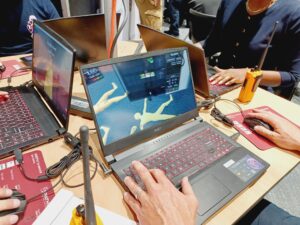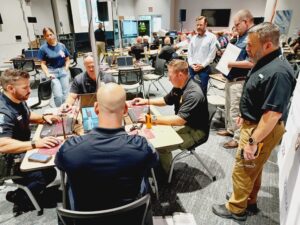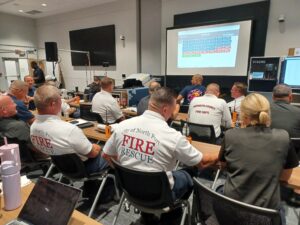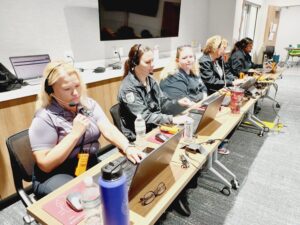A three-day course educates law enforcement officers and EMTs on crisis management.
By Ramon Lopez
Original Air Date: October 24, 2025
Host: Sarasota first responders practiced how to handle active shooter situations. Ramon Lopez was at Sarasota Memorial Hospital to watch and witness.

First responders from various agencies tried to get on the same page during the ‘active shooter’ exercise. Photos: Ramon Lopez
Participant 1: Is everybody okay here? Is there anybody hurt?
Participant 2: In here? There’s no one hurt. I just want to go home. I want to take my daughter with me. Can you bring Judge House here with the custody paperwork? I just want to go home.
Hey! Get out of there! Get out of that room right now! Anyone gets hurt, it’s your fault.
Ramon Lopez: Multi-agency active shooter classroom-based training was recently conducted at the Sarasota Memorial Hospital campus. It provided hands-on incident management experience for Sarasota County first responders. They included participants from county-wide law enforcement, fire departments, dispatch and emergency management agencies.
You just overheard a training class for a county courthouse active shooter incident. Patrol officers have responded and are talking with the gunman who is holding hostages. EMTs are treating shooting victims. A command post is being set up, and SWAT is on the way.
 In all, the management training covers 11 active shooter scenarios, including courthouse, school, shopping mall and hospital incidents. While tactics of active shooter incident response is important, overall management of the scene is essential. So says Sarasota County Fire Department Assistant Chief of Special Programs Tim Dorsey.
In all, the management training covers 11 active shooter scenarios, including courthouse, school, shopping mall and hospital incidents. While tactics of active shooter incident response is important, overall management of the scene is essential. So says Sarasota County Fire Department Assistant Chief of Special Programs Tim Dorsey.
Tim Dorsey: Normally, when we exercise and train on active shooter events, we work on the tactical aspects of response, which is getting the law enforcement officers on the scene to address the threat, getting the fire and EMS resources in to manage and treat the patients to save their lives and stop the bleeding and stop the problems. What we don’t necessarily get to always do are the strategic points of incident management and dealing with the overarching goals and those processes involved with managing the complete scene up to and including utilizing emergency management to set up reunification. All of those different facets that happen with these incidents—we don’t get to replicate those. The other good part about this 24-hour class is that it goes through 11 different simulations from a very minor situation to a very major, complex situation.
 RL: The course, funded by the Department of Homeland Security and FEMA, is offered to local agencies at no cost. It was created by training centers at Texas A&M and Texas State University.
RL: The course, funded by the Department of Homeland Security and FEMA, is offered to local agencies at no cost. It was created by training centers at Texas A&M and Texas State University.
The three-day, 24-hour course is hands-on and designed to train, integrate and prepare various first responders to manage and mitigate an active shooter incident.
Sarasota County signed up for the training course two-and-half years ago. Sixty county workers were trained, including 30 county lawmen and 20 fire/EMS personnel. Dorsey wants more county first responders to go through the course.
Dorsey says the course provides “muscle memory” needed for the critical work.
TD: What this does is it helps to build muscle memory in our people. That’s what we look for in training. We want to build muscle memory in our people.
 RL: Command and control is essential for active shooter response, as the tragic Uvalde school shooting showed. The law enforcement response to the mass shooting in Uvalde, Texas was deemed an “abject failure” in an after-action report. A sufficient number of armed officers were on hand, but the on-scene commander “decided to place the lives of officers before the lives of children.”
RL: Command and control is essential for active shooter response, as the tragic Uvalde school shooting showed. The law enforcement response to the mass shooting in Uvalde, Texas was deemed an “abject failure” in an after-action report. A sufficient number of armed officers were on hand, but the on-scene commander “decided to place the lives of officers before the lives of children.”
Dorsey said lessons learned have established clear-cut leadership responsibility.
TD: What we do in a complex incident like that is we have what’s called a unified command. That way, the leadership and the top-ranking person for each organization would be in that structure, and then they would cohesively make those decisions together.
RL: This is Ramon Lopez for WSLR News.
WSLR News aims to keep the local community informed with our 1/2 hour local news show, quarterly newspaper and social media feeds. The local news broadcast airs on Wednesdays and Fridays at 6pm.